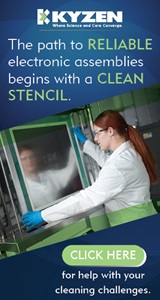|

|
|
| Ask the Experts | |||||||
|
|||||||
|
July 18, 2024 - Updated June 23, 2020 - Originally Posted Mixed MSL BakingIf the highest MSL-rated component on a PCB had a 27-hour bake time at 125C (1.4-2.0mm, MSL 3) and the PCB had to be baked to replace a different component that required an 18-hour bake time (1.4-2.0mm, MSL 2), what is the preferred avenue of approach? 1. Bake the PCB for 27 hours at 125C because that's the highest rating of a component on the PCB, regardless of the component needing rework. OR 2. Bake the PCB for 18 hours at 125 because that's the rating of the component needing rework, regardless of the other components. B.B. |
|||||||
| Expert Panel Responses | |||||||
|
Thanks for the interesting question. I believe the answer lies with the component to be replaced or reworked. If that component has a specific MSL rating and is already mounted on the board, then follow the requirement for that component. The reflow profile should target that specific component so the other should not be damaged. If the component is to be replaced, then verify the dryness of the component and install it with the unique product thermal profile.
Vice President, Technical Director EPTAC Corporation At EPTAC Corporation, Mr. Lambert oversees content of course offerings, IPC Certification programs and provides customers with expert consultation in electronics manufacturing, including RoHS/WEEE and lead free issues. Leo is also the IPC General Chairman for the Assembly/Joining Process Committee.
Bake to the higher MSL device/Board listed. The reason is the board and surrounding components most likely will see higher temperatures than the 125°C required for the MSL listed during rework and this will remove any risk. Something to consider is if any secondary components on the board are temperature sensitive, as in connectors, batteries, etc.
Engineering Manager Circuit Technology Center, Inc. Manufacturing Engineer of 20+ years. Involved in Industries relating to all sectors of defense, Commercial product Industries, RF - Microwave and Semiconductor industries. Vast knowledge and experience relating Mil-STD’s, IPC-STD’s, EAI-STD’s, GEIA-STD’s, J-STD’s and MIL-PRF-STD’s.
Need a little more information regarding the situation. E.g. what type of rework is going to be performed (hot air, IR, solder iron), how will the part with the higher MSL be effected by the rework, is there a means of shielding the part. We have gone away from forced air rework equipment and are using IR wherever we can to focus the heat on the component being reworked and we also shield any specifically sensitive components. If the plan is to heat part with the higher MSL and there is a concern, then I would suggest playing it safe and baking longer. But again I would need more information regarding the rework process to give sound advice.
Director of Corporate Quality Assurance Delta Group Electronics Inc. Tod has been working in the Aerospace Electronics Industry for 25 years, beginning with 4+ years working for PCB fabricator ending as the Quality Manager and 20 years with Delta Group Electronics Inc. an AS9100 registered electronics contract manufacture. Currently position is Director of Corporate Quality Assurance.
Unless you plan to re-heat the entire PCB assembly to reflow temperature during the re-work process, you only need to bake the PCB assembly long enough to meet the bake requirements (J-STD 033) for the component being re-worked/replaced, and or any other components near the re-work area that MAY also reach reflow temperature, and whose MSL is the same or higher than the component being re-worked/replaced. If you are replacing the component, then who cares if that component it baked prior to removal, assuming you are going to throw it away. The new component being added however, must have been kept "dry" or baked per J-STD 033 prior to reflowing it onto the PCB during rework.
Senior Project Engineer Electronic Controls Design Inc Paul been with Electronic Controls Design Inc. (ECD) in Milwaukie, Oregon for over 39 years as a Senior Project Engineer. He has seen and worked with the electronic manufacturing industry from many points of view, including: technician, engineer, manufacture, and customer. His focus has been the design and application of measurement tools used to improve manufacturing thermal processes and well as moisture sensitive component storage solutions.
The safe bet would be to bake the assembly long enough to satisfy the most stringent requirement. If the component requiring the longer bake could be isolated or protected from the rework process, you could probably get by with the shorter bake cycle. Depends on the component proximity and the rework method.
Principal Product Engineer Benchmark Electronics, Inc. 30+ years of experience working with electronic and electro-mechanical manufacturing and design (medical, automotive, military, computer, and industrial controls). Military veteran - served as a Combat Engineer with the United States Marine Corps.
If the level 3 component is already placed on the pcs (completed assembled board) then the second avenue is recommended. The reason for baking is assuring moisture is not present in the component anymore while reflowing it.
Engineering and Operations Management Independent Consultant Georgian Simion is an independent consultant with 20+ years in electronics manufacturing engineering and operations.
Contact me at georgiansimion@yahoo.com. |
|||||||
| Submit A Comment | |||||||
|
Comments are reviewed prior to posting. You must include your full name to have your comments posted. We will not post your email address. |
|
Free Newsletter Subscription
Circuitnet is built for professionals who bear the responsibility of looking ahead, imagining the future, and preparing for it. Insert Your Email Address |
|

|








